And one of those was Harry Anderson.
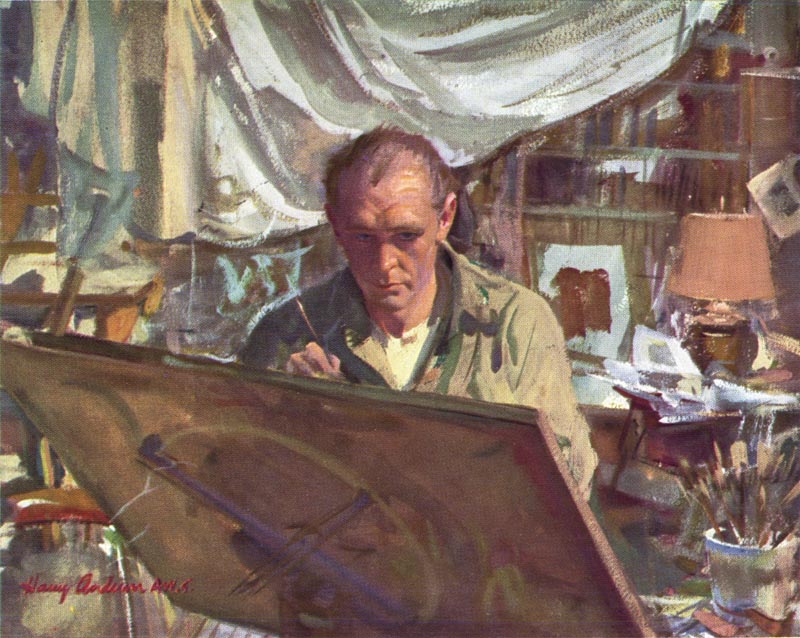
From Norman Kent's text:
Harry Anderson always works with tempera, a prepared, opaque tube color, using only those colors advertised by their makers as absolutely permanent, namely: burnt sienna, burnt umber, raw umber, yellow ochre, cadmium yellow, lemon yellow, permanent green light, permanent green deep, pogany blue (near cerulean), cobalt blue, alizarin crimson, vermilion, show-card white. He uses no violets or black. For his darks, he combines pogany blue with alizarin or permanent green deep with alizarin.
He prefers a rough handmade watercolor paper, mounted on board in the heavy weights. His brushes are the finest grades red sables and oil bristle brushes, which he uses to paint any solid, opaque passages.
In painting a landscape - the picture reproduced here is his first portrait in watercolor - Anderson works directly from nature or from color slides. He makes no preliminary sketch, but works directly on the full sheet with brush and color. He has, however, a clear idea of the final composition by the time he puts brush to paper.
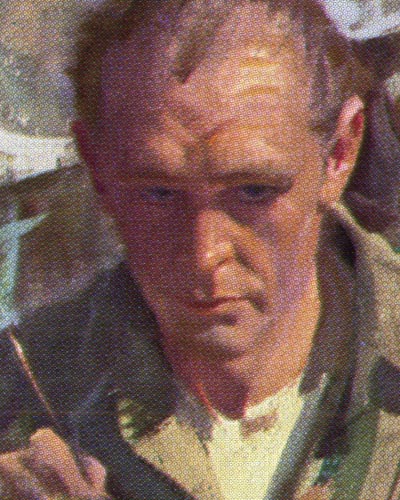
(Sorry, I just have to interrupt here and wonder aloud why Kent decided to show a - unintentionally menacing, I'm sure - self portrait of the artist when the bulk of the technique discussion focuses on how Anderson paints a landscape! Anyway, to continue...)
As he starts to paint, he lays in all the color areas as quickly as possible so that the arrangement becomes clear. he pays little attention to detail at this stage. Starting with the sky and the distance, Anderson works towards the foreground. he pays particular attention to the sky in his painting, believing that the sky should be a foil for the rest of the design.

When dry, his tempera color has almost the same appearance as transparent color. (For that matter, most colors found in any "transparent" palette are not really transparent, but appear so only because of their dilution with water.) Sometimes Anderson applies solid opaques in finishing painting. To lighten or change a passage, he hesitates to use solid, opaque color, and apply light on dark. He prefers to scrub out the area first and then repaint it.

Frequently, the artist uses his fingers or, more accurately, his thumbs in manipulating the color for different effects. He is always watchful for desirable "accidental" passages which, when found effective, he is careful to retain.
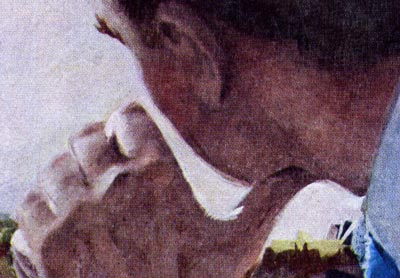
Anderson uses two different colors on a single bristle brush when he paints objects whose color might run from light to dark - such as a cylinder, for example. First he loads the brush with the lighter hue and then, with a section of the brush, he picks up the darker paint so that when the stroke is made, very interesting accidental effects result. This works very well on small objects.

At times he carries his partly finished outdoor paintings to the studio for completion. After he has tentatively finished a painting, he turns its face against a wall for several days and then brings it out for a fresh look. He may examine it upside down or in a mirror to detect any flaws. Following this, final corrections are made and the painting is ready for framing.
ADDENDUM
Below, a note from TI list member Kent Steine:
Hi Leif,
Nice to see the Harry article (originally published in a '56 American Artist, I believe). One of the most interesting aspects about Harry was his switch to opaque watercolors after he became alergic to turpentine.
He did in fact use tempera for a time while trying to find a substitute for the body and pull of oil paint, but ultimately settled on casein. Many of Harry's best paintings were produced with this media. He also found the task of actually finding casein difficult, and apparently switched back and forth from tempera to casein, favoring the latter.
By the time I met Harry, he hadn't been able to find it for a while. I actually purchased his last tubes of casein as a gift. It was a starter set of 12 hues, that had recently been introduced by Shiva. However, as I later found out, he had already pretty much decided to retire from painting.
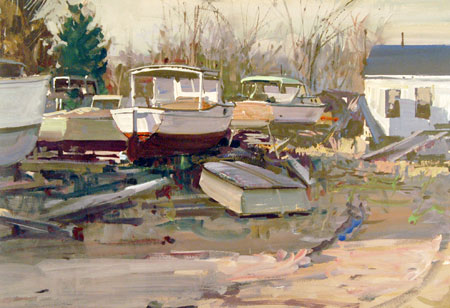
My point. . . the difference between casein and tempera is the body and texture of the paint. They're both opaque watercolor media, but the casein is full bodied and very creamy right out of the tube. The opaque effects you can get with this stuff really looks like oil, with the exception of drying to a matte finish. I feel that all of Harry's great abilities and techniques worked best with casein. And for what it's worth, is the only paint I know of that actually has a pleasant fragrance. Great stuff.
It is also the oldest known form of pigmented media, going way back. The vehicle binder was traditionally made from rennin, from the gastric juices of calves. I believe there are additives for acrylics that can produce a similar effect of increasing the viscosity, or body of the paint (I think they're called "short and long" rheology formulas).
The photo of Harry (below) is from 1990, and one of the first times I met him. We're sitting at his kitchen table looking at one of my sketchbooks.
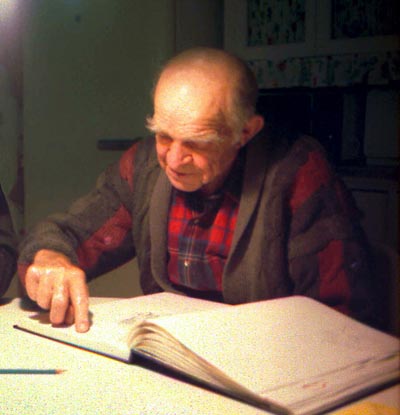
* Many thanks to Kent for sharing both this photo and his insight with us!
* My Harry Anderson Flickr set.
It's great to see Harry Anderson back in TI, Leif. He was really an extraordinary painter (although I agree that the self-portrait is dismal). I would urge anyone who wants to see some real first class painting to check out your Flickr page for the Ladies Home Journal illustration of the little boy sick in bed. Yowza!
ReplyDeleteWow, Anderson is a master.
ReplyDeleteHey
ReplyDeleteJust a question. When they say tempera do they mean gouache ?
It sure looks like gouache.
Larry; I'm pretty sure they mean gouache.
ReplyDeleteIncidentally, although I'd heard this before, I'm still amazed at Anderson's ability to get some pretty deep, dark shadows without using black or purple.
I sure do love how he handled gouache. He and John Gannam are a couple of my faves because they used watercolors in such a painterly way. Have you profiled John Gannam here yet? There is so little out there on him it's a shame.
ReplyDeleteIn the first image, what is the artist using as a table? The name of it? It's a single-legged adjustable top, but I don't know the name. I've been looking for one of those forever!
ReplyDeleteWow what a painter Anderson was. I will say however that his watercolor technique looks like an imitation of an oil painting. Yes, we know about his allergy, but its not watercolor in the true sense is it? Fantastic result though,a very humble genius and that's a much overused term.
ReplyDeleteIt's my understanding that Anderson's medium of choice was casein, which is a type of tempera (as is egg tempera - casein comes from milk.) I'm sure he worked in gouache as well, or that the mediums were misidentified later, since they can look very similar. I love both these mediums, myself.
ReplyDeleteHis work has been an inspiration to me for many years.
Are there any other illustrators in this book?
db; there are quite a few - some of whom will be featured here some time soon, I hope:
ReplyDeleteWarren Baumgartner, C.C. Beall. walter Biggs, Mario Cooper, Dong Kingman, John Pike, Henry C. pitz, Morton Roberts, and the one I was most excited to find, Alex Ross!
Chad;
ReplyDeleteThat resemblance to oil painting was quite intentional from what I understand. Anderson style was that 'buttery' Chicago school of illustration made famous by Haddon Sundblom and, as you mentioned, couldn't work with oils because of his allergies, so found a way to make his watercolours look like oils. I suppose that must be part of the reason Norman Kent wanted him included in this book... to show just how versatile watercolour media could be when manipulated by a masterful artist. That's my guess, anyway. :^)
Michael; I have a set of Gannam illustrations on Flickr:
ReplyDeletehttp://tinyurl.com/qb7qph
And have written a little about him in passing, but you're right, we need to spend a proper week on his career. I just don't have a ton of info on him. Anyone out there interested in doing a week on John Gannam as a guest author?
I am!
ReplyDeleteThat'll be good.Gannam was an absolute master at tones.Bring it on!
ReplyDeleteGreat, got to love second hand book shops. Good article, interesting. I have a new art/watercolour website going live any day now, have a look like you have time. www.bibigallery.com
ReplyDeleteA number of Anderson's works, some of his artist materials and in general, things bearing on his work are on display in an area of the World Headquarters of the Seventh-day Adventist Church in Silver Spring, MD.
ReplyDeleteI'd heard that Anderson switched back to oils with the advent of odorless mineral spirits. Is it definitive that he painted in casein and never went back to oils?
ReplyDeleteThank you for this article and your site.
I am looking for Harry Anderson's print Christ walking with children and with a little dog walking beside him. My mother had this print but it was lost when her house burned. I have been looking for it everywhere. It may be called The Children's Friend. I would like to purchase a copy. Please help! rebeccaware57@gmail.com
ReplyDelete